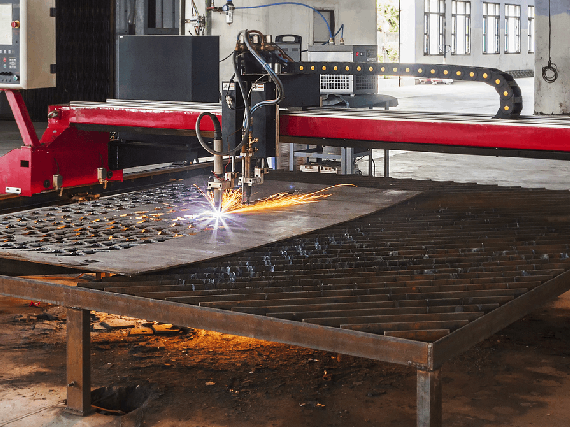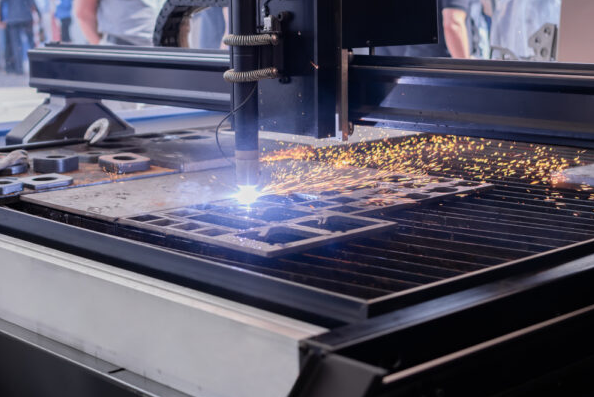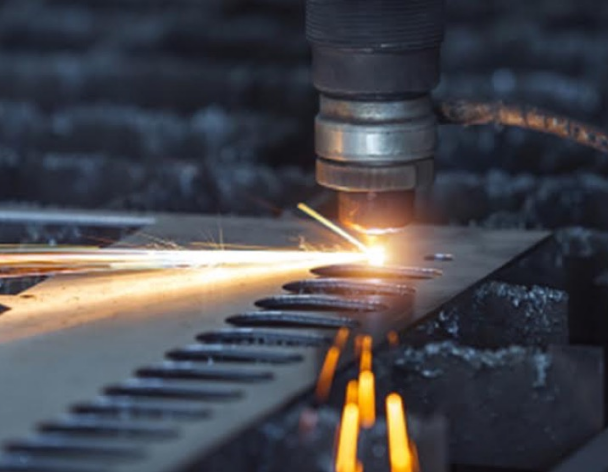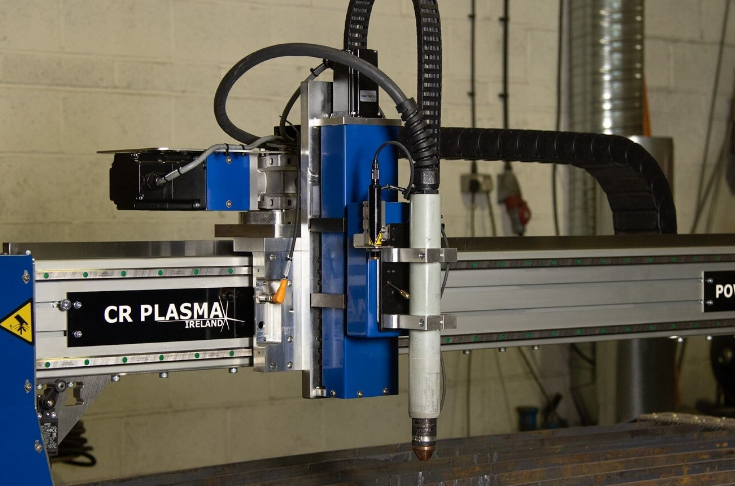Understanding CNC Plasma Cutting
CNC plasma cutting stands as a pivotal technology in modern fabrication, revolutionizing how industries handle metal cutting tasks. This process involves directing a plasma torch under computer control to cut through various types of materials. The key advantage of CNC plasma cutting lies in its ability to cut through diverse metals with remarkable speed and precision.
Basics of CNC Plasma Cutting
The essence of CNC plasma cutting centers around its two core components: the plasma torch and the CNC (Computer Numerical Control) system. The plasma torch, typically powered by an electric arc, superheats a gas—often a mixture of oxygen, nitrogen, or argon—into plasma. This plasma, reaching temperatures up to 30,000°C, effortlessly melts the metal for cutting.
In terms of efficiency, CNC plasma cutters can reach a cutting speed of up to 500 inches per minute, depending on the material thickness and type. Their precision often leads to a cutting tolerance within ±0.5 mm, making them suitable for intricate designs and patterns. However, the initial cost for a standard CNC plasma cutter can range from $15,000 to $300,000, influenced by power capacity, size specifications, and additional features.

Evolution of CNC Plasma Technology
CNC plasma technology has evolved significantly since its inception. Early plasma cutters were manual and lacked the precision of modern machines. With advancements in digital technology, modern CNC plasma cutters now incorporate sophisticated software and precise motion control systems. These improvements have dramatically enhanced the quality and speed of cuts.
Today, CNC plasma cutters can handle materials of varying thicknesses, generally up to 6 inches. The introduction of high-definition plasma systems has further refined the cutting quality, especially for thinner materials, where the edge quality and angularity have seen marked improvements.
Furthermore, developments in automation and integration with other manufacturing systems have opened new avenues for efficiency and productivity. Modern CNC plasma systems can be easily integrated with CAD (Computer-Aided Design) and CAM (Computer-Aided Manufacturing) software, streamlining the design-to-production workflow.
These advancements have not only improved the capabilities of CNC plasma cutters but have also reduced operational costs and increased the lifespan of consumables, making it a more cost-effective solution in the long run. For instance, the average lifespan of a plasma torch consumable set can range from 4 to 6 hours of cutting time, depending on the material and cutting parameters.
In summary, CNC plasma cutting continues to evolve, offering ever-increasing precision, efficiency, and versatility. Its impact on industries ranging from automotive to construction underscores its critical role in modern manufacturing processes. For more detailed information on CNC plasma cutting, you can visit the CNC Plasma Cutting Wikipedia page.
Factors Affecting Accuracy
The accuracy of CNC plasma cutting hinges on several critical factors, each contributing significantly to the final outcome. Understanding these factors not only enhances the precision of cuts but also ensures optimal usage of the CNC plasma cutter. Key elements like machine calibration, material properties, and maintenance routines play a pivotal role in determining the accuracy and quality of cuts.
Machine Calibration and Maintenance
Proper calibration of a CNC plasma cutter is crucial for achieving precise cuts. Regular calibration ensures that the cutting torch aligns perfectly with the intended cutting path, mitigating errors caused by misalignment. For instance, even a slight deviation of 0.1 mm in torch alignment can lead to significant inaccuracies in the final product.
Maintenance of the CNC plasma cutter equally affects its accuracy. Routine checks and replacements of worn-out parts, such as the nozzle and electrodes, are essential. These components directly influence the plasma arc’s stability and cutting precision. The cost of consumables, such as nozzles and electrodes, can range from $15 to $100, depending on the quality and brand.
Material Type and Thickness
The type and thickness of the material being cut are critical factors influencing the accuracy of CNC plasma cutting. Different materials react differently under high temperatures, affecting the cut quality. For example, cutting aluminum requires different settings than cutting steel due to their varying melting points and thermal conductivity.
Thickness plays a vital role as well. Thicker materials require more power and slower cutting speeds to achieve clean cuts. A CNC plasma cutter might operate at a power level of 45 amps for thin sheets (up to 6 mm) but may need to ramp up to 200 amps for materials over 20 mm thick. This adjustment in power and speed is essential to maintain precision in thicker materials.
In conclusion, factors like machine calibration, maintenance, material type, and thickness directly influence the accuracy and efficiency of CNC plasma cutting. For an in-depth understanding of these factors, you can refer to the CNC Plasma Cutting Wikipedia page. These aspects are vital for achieving the desired precision and quality in various industrial applications, making them fundamental considerations in CNC plasma cutting operations.
Precision Capabilities
CNC plasma cutting distinguishes itself with its remarkable precision capabilities, setting it apart in the realm of metal fabrication. This method combines high-speed cutting with exceptional accuracy, catering to intricate designs and tight tolerances.
Tolerances in CNC Plasma Cutting
In CNC plasma cutting, tolerances significantly influence the final product’s quality. Typically, these machines maintain a cutting tolerance ranging from ±0.5 mm to ±3 mm, depending on the system’s setup and the material’s thickness. For instance, thinner materials often result in tighter tolerances, whereas thicker materials might exhibit slightly larger deviations.
The precision of CNC plasma cutters also depends on factors like the machine’s condition, torch-to-material distance, and cutting speed. Regular maintenance and calibration are crucial to maintaining these tight tolerances. For more insights, the CNC Plasma Cutting Wikipedia page offers detailed information on the technology and its capabilities.
Comparison with Other Cutting Methods
Comparing CNC plasma cutting with other methods, like laser or waterjet cutting, highlights its unique strengths and limitations. While laser cutting offers even tighter tolerances, typically around ±0.1 mm, it comes with higher operational costs. CNC plasma cutting, on the other hand, balances cost-efficiency with reasonably tight tolerances, making it a preferred choice for thicker materials.
In contrast, waterjet cutting excels in versatility, cutting through various materials, including metals, glass, and composites, without thermal distortion. However, waterjet cutting is slower than CNC plasma cutting and often more expensive due to higher maintenance and operational costs.
In conclusion, the precision capabilities of CNC plasma cutting make it an indispensable tool in many industries. Its ability to maintain tight tolerances while offering faster cutting speeds and lower operational costs than some alternatives underscores its value in modern manufacturing.
Software and Control Systems
In the realm of CNC plasma cutting, software and control systems form the backbone of operational efficiency and precision. These systems not only streamline the cutting process but also enhance the quality and accuracy of the end product.

Role of Software in Precision
Software in CNC plasma cutting plays a pivotal role in achieving high precision. Advanced software solutions translate complex designs into precise cutting paths, ensuring that the plasma torch follows the exact contours and dimensions specified in the design. For example, modern CNC software can optimize cutting patterns to minimize waste and maximize material usage, directly impacting cost-effectiveness.
The software also allows for fine-tuning of cutting parameters such as speed, power, and gas flow, which are essential for achieving the desired cut quality and accuracy. This level of control is particularly important when working with diverse materials and varying thicknesses, as each requires specific settings for optimal cutting.
Advances in Control Systems
Control systems in CNC plasma cutting have seen significant advancements over the years. Today’s systems feature enhanced motion control, allowing for smoother and more precise movements of the plasma torch. This improvement directly translates to better cut quality and reduced material wastage.
Additionally, modern control systems integrate more effectively with CAD (Computer-Aided Design) and CAM (Computer-Aided Manufacturing) software, facilitating a seamless transition from design to production. Such integration not only speeds up the production process but also minimizes the risk of errors, ensuring that the final product closely matches the original design.
The evolution of control systems has also led to increased automation in the cutting process. Automated features like height control and torch collision detection enhance the machine’s operational life and reduce downtime due to maintenance. For instance, automatic height control systems adjust the torch height in real-time, compensating for any warping in the material being cut.
In summary, software and control systems are vital components that significantly enhance the precision and efficiency of CNC plasma cutting. By leveraging advanced software and control technologies, CNC plasma cutting continues to evolve, offering higher accuracy and better integration with modern manufacturing processes. For an in-depth exploration of these systems, the CNC Plasma Cutting Wikipedia page provides a wealth of information.
Practical Applications and Limitations
CNC plasma cutting, a versatile and powerful technology, finds extensive application across various industries while also having certain limitations that define its scope of use.
Industrial Use Cases
In industrial settings, CNC plasma cutting plays a crucial role. It is widely used in automotive manufacturing for creating precise and intricate parts rapidly. The construction industry benefits from its ability to cut large and thick metal sheets, essential for building structures.
Another significant application is in metal fabrication shops, where CNC plasma cutting provides flexibility in producing custom parts and prototypes. Its speed and precision make it ideal for high-volume production runs, significantly reducing turnaround times and increasing efficiency.

Furthermore, the aerospace industry utilizes CNC plasma cutting for fabricating components that require precise tolerances and high-quality cuts. This technology’s ability to handle various metals, including high-strength alloys, makes it invaluable in producing lightweight yet sturdy parts.
Limitations in Fine Detail Work
While CNC plasma cutting offers many advantages, it has limitations in executing extremely fine detail work. The nature of the plasma torch creates a kerf, or cut width, which can be too wide for very intricate designs, especially when working with thicker materials.
For example, while cutting metal sheets thinner than 1 mm, the precision might decrease, affecting the quality of fine details. This limitation makes CNC plasma cutting less suitable for applications requiring extremely fine or intricate cuts, such as detailed artistic work or micro-components used in electronics.
Moreover, thermal distortion is a factor to consider. The intense heat generated by the plasma torch can sometimes warp thinner materials, affecting the accuracy and aesthetics of the final product. This aspect necessitates careful planning and setup, especially when dealing with sensitive or thin materials.
In summary, while CNC plasma cutting excels in many industrial applications due to its speed and versatility, it has limitations when it comes to very fine detail work and handling extremely thin materials. To delve deeper into the applications and limitations of CNC plasma cutting, the CNC Plasma Cutting Wikipedia page offers comprehensive information.
Improving Cutting Accuracy
Enhancing the accuracy of CNC plasma cutting is an ongoing pursuit, crucial for maximizing both quality and efficiency in metal fabrication.
Techniques for Enhanced Precision
Several techniques play a pivotal role in improving the precision of CNC plasma cutting. Firstly, regular machine calibration is essential. Ensuring the alignment of the plasma torch and maintaining consistent torch height can dramatically reduce errors in cutting.
Upgrading software and control systems also contributes significantly to precision. Using the latest software versions ensures that cutting paths are calculated with the utmost accuracy, minimizing deviations from the intended design.
Another technique involves optimizing cutting parameters like speed, power, and gas type based on the material being cut. For example, reducing the cutting speed can lead to cleaner edges and finer details, especially in thicker materials.
Proper maintenance of consumables, like nozzles and electrodes, is crucial. Worn-out parts can degrade the plasma arc’s quality, directly impacting cut accuracy. Regularly replacing these parts ensures consistent cutting performance.

Future Developments in CNC Plasma Cutting
The future of CNC plasma cutting looks promising, with technological advancements poised to further enhance its accuracy. One area of development is the integration of AI and machine learning algorithms. These technologies can predict and compensate for potential inaccuracies in real-time, adjusting parameters automatically for optimal cuts.
Another exciting development is the improvement in motion control systems. More advanced systems will allow for even smoother and more precise movements of the cutting torch, reducing the likelihood of errors.
The evolution of plasma torch technology itself, with innovations in nozzle and electrode design, will also play a key role in enhancing precision. These advancements will allow for finer control of the plasma arc, enabling more intricate and detailed cuts.
In conclusion, through regular maintenance, software updates, optimized cutting parameters, and embracing technological advancements, the precision of CNC plasma cutting can be significantly enhanced. These improvements not only increase the quality of the cuts but also expand the range of applications for CNC plasma cutting. For a deeper understanding of these advancements, the CNC Plasma Cutting Wikipedia page offers valuable insights.
